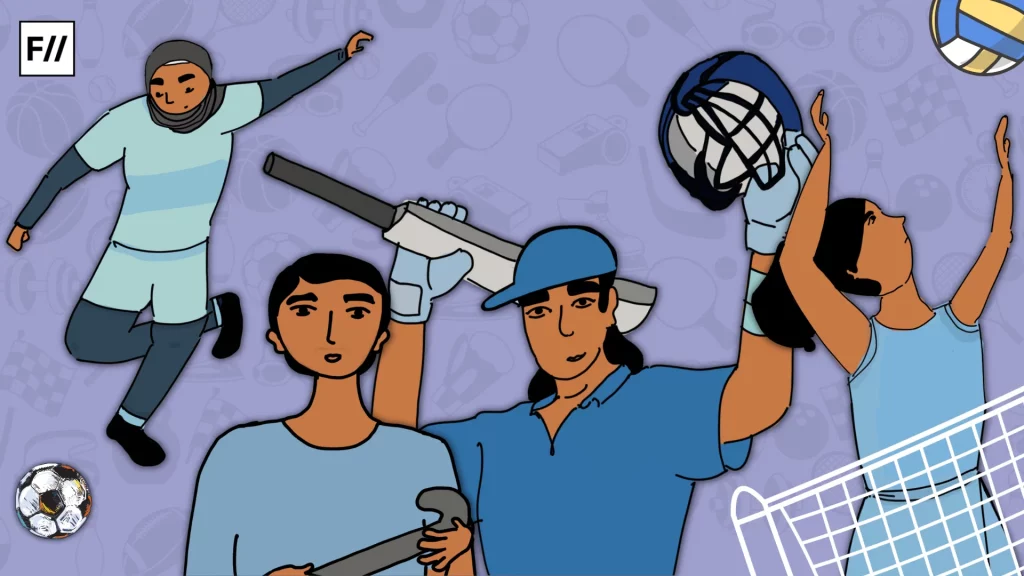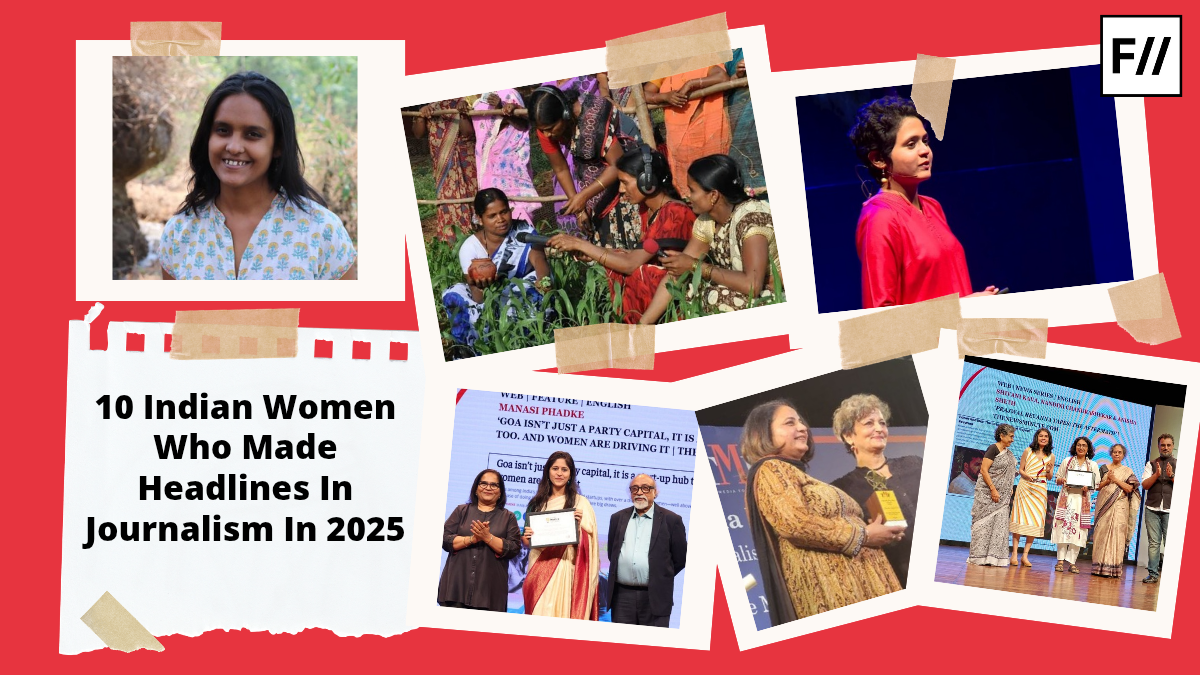On November 2 when the Indian women cricketers lifted the ICC Cricket World Cup, they became a beacon of hope for girls who want to take up the game in future. The willingness to smash societal norms has been profound among the women cricketers for a long time. It has, for a long time, been ridiculously believed that women are not meant for sports like cricket, as it requires masculine traits. It is unscientific to assume that women do not need to participate in sports; they are not designed for them.
Before beginning with bringing societal norms into consideration that prevent girls and women from taking up sports as their profession and hobbies, it is much more important to understand that these societal norms are not some scientific biological facts. But these discriminatory norms are narrated and preserved to maintain dominance in different fields, including sports.
The willingness to smash societal norms has been profound among the women cricketers for a long time. It has, for a long time, been ridiculously believed that women are not meant for sports like cricket, as it requires masculine traits. It is unscientific to assume that women do not need to participate in sports; they are not designed for them.
Two well-defined social constructs, masculinity and femininity, which society defines, have no connection with biological traits that people have. Like race, caste and class, these two social constructs are used to maintain dominance in a patriarchal society. Collins Dictionary defines masculinity as a characteristic of a man and mentions synonyms, which are ‘maleness’, ‘manhood’, ‘manliness’, ‘courage’, ‘bravery’, ‘boldness’, ‘firmness’, ‘boldness’, ‘hardihood’, etc. These are attributed to men, whereas for women, it defines synonyms for femininity that are femaleness, womanhood, womanliness, girlishness, etc. In a patriarchal setup, on the one hand, men are considered emotionally strong, rational, masculine, problem solvers and decision makers. On the other hand, women are deemed sensitive, irrational, caretakers and weak.

It is clear that masculinity and femininity are socialising ideologies that define the way men and women should behave. It is worthwhile to note that both these ideologies are differently defined in different societies in the world. In Palestine, Israeli men are considered masculine, whereas Palestinian men are feminine. In a broader sense, these attributes are confined to men’s and women’s behaviours.
Cricket: a game labelled ‘men only’
These attributes are also taken into consideration or repeated when it comes to their participation in sports like cricket. Cricket has for a long time been considered masculine or a game of men in Indian society. In fact, the Indian cricket team is recognised as a team of male players who hold the nation’s pride and the nation’s expectations to see them winning cups all the time. It is all about professional-level cricket that is male-dominated. At the local level, from streets to parks, it is boys who hold bats and balls and dominate areas. On the other hand, girls are not considered suitable for the game, as, according to societal norms, their participation does not hold masculine traits.
There are a number of reasons that are repeated quite often in society to prevent girls from taking up sports: playing in the sun makes girls tanned, or girls’ bodies are not for sports like cricket because of weakness and gentleness. These societal reasons have historically been used to prevent them from playing sports. In actual terms, girls’ and women’s participation in cricket can be seen as a threat to men’s position, and that is the reason for considering men as preservers of the game.
Beacon of hope for girls in India
As the Cricket World Cup was lifted by the Indian cricketers, India became the first Asian country to do so. It can be taken as a hope for girls choosing cricket as their hobby and career option without societal barriers. Although gender discrimination is so profound, their winning still motivates girls to opt for the game.
It does not mean that their victorious moment has not been met with gender stereotypes and discrimination. Although there are videos, reels and posts going viral on social media celebrating women’s win in the World Cup in 2025, there are also visual records comparing them with Kapil Dev, Sachin Tendulkar and Virat Kohli, not still accepting them as a separate entity, and winning the cup based on their ability, passion and dedication. Like Mithali Raj, who is called the Lady Tendulkar of Indian women’s cricket, Smriti Mandhana is being compared to Virat Kohli for batting skills. It was even more evident in 2020 when Mandhana was called the Virat Kohli of women’s cricket by former New Zealand cricketer Scott Styris during a commentary at the Women’s T20 World Cup. In fact, she became the fastest Indian cricketer to reach 5000 ODI runs in 112 innings, surpassing Virat Kohli’s 114.
It displays a male-dominated mindset of people, as the game is seen in their consideration as of male players who are considered ideals and able. This dominance does not end here but prevails to a great extent.
There is a stand-up comedy on YouTube that asks, “Don’t you think women are getting out of their control? They scream freedom as if they were in prison. Women who play on grounds were coached by men. Freedom is, in fact, defined as a mythical or unreal concept; everyone is tied to relationships, dreams, etc.” On the show, it was articulated that women want to be like men. If men play cricket, women want the same despite the fact that nobody watches women’s cricket, including girls. It can also not be stated to them that cricket does not suit girls.
As the Cricket World Cup was lifted by the Indian cricketers, India became the first Asian country to do so. It can be taken as a hope for girls choosing cricket as their hobby and career option without societal barriers. Although gender discrimination is so profound, their winning still motivates girls to opt for the game.
At first, women do not want to be the same as men but want equal opportunities to pursue their dreams. Sports are considered masculine for men, not suitable for women; that notion suppresses women’s willingness to play at local and professional levels.
There has been a huge gender gap in the field of cricket that the Indian female cricketers winning the World Cup seem to fulfil.
The unseen struggle of female players in cricket
It is very important to bring to the forefront the struggle that female players in cricket have long endured. To start with a gap in pay to players. Mithali Raj, a well-known Indian cricketer whose old clip of an interview with The Lallantop has surfaced following the historic World Cup final, revealed, “When we became runners-up in the 2005 World Cup, each of us received just Rs 1000 per match.” She further stated, “We played eight matches in that tournament, so we got Rs. 8,000 in total. Back then, we did not even have annual contracts or match fees in a proper manner.” At that time, the Women’s Cricket Association of India (WCAI) used to manage the Indian women’s cricket in an independent manner without major sponsors and financial assistance. Since there was no major fund, female players were paid accordingly. Things began to change when women were brought under the BCCI in 2006. At first, they started getting per-series, and later per-match, payments. Subsequently, they began to be included in central contracts and higher-payment scales. In 2022, the BCCI made an announcement to pay both men and women equally: Rs 15 lakh for a test match, Rs 6 lakh for an ODI, and Rs 3 lakh for a T20.
Nevertheless, there is still a huge gender-based gap in annual contracts. For men, the top category is A+, which has Virat Kohli, Rohit Sharma, Ravindra Jadeja and Jasprit Bumrah, who get Rs. 7 crore. K L Rahul, Mohammed Shami, Mohammed Siraj, Shubman Gill, and others fall under category A, who get Rs. 5 crore, whereas Suryakumar Yadav, Kuldeep Yadav, Shreyas Iyer, and others fall under category B, who get Rs. 3 crore of retainer. Under category C, Rinku Singh, Tilak Varma, Shivam Dube, and others get Rs. 1 crore. For women, the top category is A, which has Harmanpreet Kaur, Smriti Mandhana, and Deepti Sharma getting Rs 50 lakh. Under category B, there are Renuka Thakur, Richa Ghosh, Shafali Verma and Jemimah Rodrigues, who get Rs 30 lakh. Radha Yadav, Sneh Rana, Uma Chetry, Amanjot Kaur, Arundhati Reddy, and others who fall under category C get Rs 10 lakh.
At last, it is worthwhile to mention that in spite of prevailing gender stereotypes and gaps, the populace needs to accept that cricket is just a game, not a gender role. It is high time to dismantle the notion of having masculine traits and women not being suitable for the same.
About the author(s)
Nashra Rehman finds her profound interest in addressing the plight of Muslim women and their unappreciated marginalisation. Her focus remains on bringing a novel argument to life.





